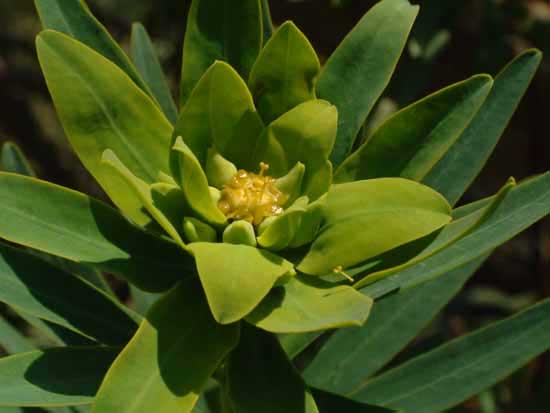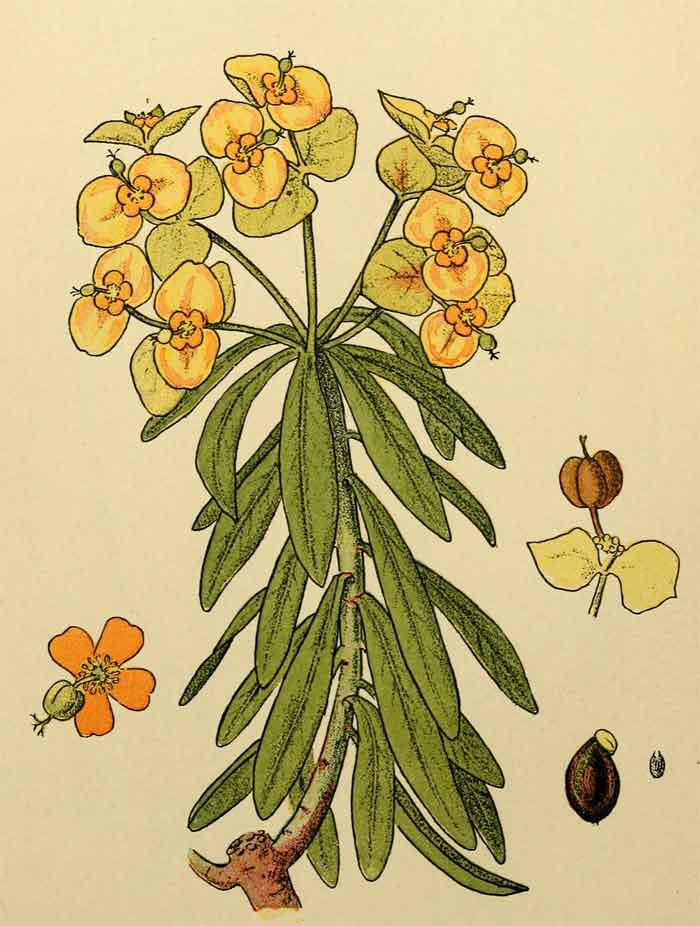
Euphorbia dendroides, (Photo: *)
Classification System: APG IV
Superregnum: Eukaryota
Regnum: Plantae
Cladus: Angiosperms
Cladus: Eudicots
Cladus: Core eudicots
Cladus: Rosids
Cladus: Eurosids I
Ordo: Malpighiales
Familia: Euphorbiaceae
Subfamilia: Euphorbioideae
Tribus: Euphorbieae
Subtribus: Euphorbiinae
Genus: Euphorbia
Subgenus: E. subg. Esula
Sectio: E. sect. Pachycladae
Species: Euphorbia dendroides
Name
Euphorbia dendroides L., Sp. Pl. 1: 462. 1753.
Synonyms
Homotypic
Tithymalus dendroides (L.) Hill, Hort. Kew.: 172.4. 1768.
Esula dendroides (L.) Haw., Syn. Pl. Succ.: 153. 1812.
Euphorbion dendroideum (L.) St.-Lag., Ann. Soc. Bot. Lyon 7: 126. 1880.
Heterotypic
Tithymalus arboreus Tourn. ex Lam., Fl. Franç. 3: 94. 1779.
Euphorbia divaricata Jacq., Icon. Pl. Rar. 1: 9. 1784.
Euphorbia laeta Aiton, Hort. Kew. 2: 141. 1789.
Tithymalus laetus (Aiton) Haw., Syn. Pl. Succ.: 140. 1812.
Notes
Euphorbia dendroides var. hesperia Jahand. & Maire, Cavanillesia 5: 14. 1932 = Euphorbia regis-jubae
Distribution
Native distribution areas:
Continental: Europe
Regional: Southwestern Europe
Baleares, Corse, France, Sardegna, Spain.
Regional: Southeastern Europe
Albania, Greece, Italy, Kriti, Sicilia (Malta, Sicily), Yugoslavia.
Continental: Africa
Regional: Northern Africa
Algeria, Egypt, Libya, Morocco (in error), Tunisia.
Regional: Macaronesia
Canary Islands (in error).
Continental: Asia-Temperate
Regional: Western Asia
East Aegean Islands, Lebanon-Syria (in error), Palestine (Israel), Turkey.
Continental: Northern America
Regional: Southwestern U.S.A.
California (naturalized).

References: Brummitt, R.K. 2001. TDWG – World Geographical Scheme for Recording Plant Distributions, 2nd Edition
References
Primary references
Linnaeus, C. 1753. Species Plantarum. Tomus I: 462. Reference page.
Additional references
Dobignard, A. & Chatelain, C. 2011. Index synonymique de la flore d'Afrique du Nord. Volume 3: Dicotyledoneae: Balsaminaceae – Euphorbiaceae. Conservatoire et jardin botaniques, Genève, ISBN 978-2-8277-0124-7, 449 pp. PDF Reference page.
Greuter, W., Burdet, H.M. & Long, G. (eds.) 1986. Med-Checklist. A critical inventory of vascular plants of the circum-mediterranean countries. Vol. 3: Dicotyledones (Convolvulaceae – Labiatae). cxxix + 395 pp., Conservatoire et Jardin Botanique, Genève, ISBN 2-8277-0153-7. Online version. Reference page.
Links
Govaerts, R. et al. 2020. Euphorbia dendroides in Kew Science Plants of the World online. The Board of Trustees of the Royal Botanic Gardens, Kew. Published online. Accessed: 2020 Jun 26. Reference page.
International Plant Names Index. 2020. Euphorbia dendroides. Published online. Accessed: Jun 26 2020.
Govaerts, R. et al. 2020. Euphorbia dendroides in Kew Science Plants of the World online. The Board of Trustees of the Royal Botanic Gardens, Kew. Published online. Accessed: 2020 Jun 26. Reference page.
Tropicos.org 2020. Euphorbia dendroides. Missouri Botanical Garden. Published online. Accessed: 26 Jun 2020.
USDA, ARS, Germplasm Resources Information Network. Euphorbia dendroides in the Germplasm Resources Information Network (GRIN), U.S. Department of Agriculture Agricultural Research Service. Accessed: 08-Apr-12.
Vernacular names
Deutsch: Baumförmige Wolfsmilch
Ελληνικά, Κυπριακά: Ευφορβία η δενδροειδής
English: Tree Spurge
español: Titímalo árbol
suomi: Puutyräkki
français: Euphorbe arborescente
sardu: Euforbia arborescente
Euphorbia dendroides, also known as tree spurge, is a small tree or large shrub of the family Euphorbiaceae that grows in semi-arid and mediterranean climates.
Distribution and habitat
Euphorbia dendroides has a wide distribution throughout the Mediterranean Sea, from the Balearic Islands in the west to the Aegean Islands in the east. It is found primarily in Europe and is restricted to northern Tunisia in North Africa.[1][2] This plant is sensitive to frost, so it only grows on protected and sunny mountainsides in hilly areas. It has been introduced to other countries out of its original range as an ornamental tree.
Description
This bush also has uses in traditional medicine; like many other species of genus Euphorbia[3] its toxic white and sticky sap has been used to treat skin excrescences, like cancers, tumors, and warts since ancient times.
References
Wilson, B. (2018). "Euphorbia dendroides". IUCN Red List of Threatened Species. 2018: e.T79914128A119836518. doi:10.2305/IUCN.UK.2018-1.RLTS.T79914128A119836518.en. Retrieved 19 November 2021.
"Euphorbia dendroides" (PDF). Flora Iberica. Retrieved 30 March 2021.
Lletereses
Retrieved from "http://en.wikipedia.org/"
All text is available under the terms of the GNU Free Documentation License

